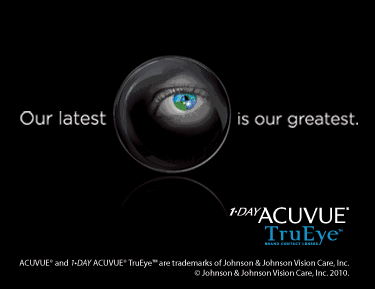|
Vistakon Introduces Acuvue Advance Plus
Vistakon, Division of Johnson & Johnson Vision Care, Inc., announced the launch of Acuvue Advance Plus Brand Contact Lenses with Hydraclear Technology.
Acuvue Advance Plus is a redesigned and enhanced successor to Acuvue Advance Brand Contact Lenses. Along with Hydraclear Technology, Acuvue Advance Plus offers improvements in initial and overall comfort, as well as visual clarity, along with the highest level of UV protection in a contact lens, blocking more than 90 percent of UV-A rays and 99 percent of UV-B rays that reach the lens, according to the company. Acuvue Advance Plus also employs Ultra-Clean Technology to help resist deposits.
For patients, Acuvue Advance Plus provides the freshness of a two-week modality at a price comparable to a monthly lens. The lens comes six to a box, and the 24-pack value packaging makes the purchase of an annual supply more affordable for wearers.
The lens is available in base curves of 8.3mm and 8.7mm at parameters of -0.50D to -6.00D and +0.50D to +6.0D in 0.25 increments and from -6.50D to 12.0D and +6.50D to +8.0D in .50D increments.
Acuvue Advance Plus will gradually replace Acuvue Advance. Vistakon will discontinue providing Acuvue Advance diagnostics effective November 1, 2010.
More information on Acuvue Advance Plus is available at www.jnjvisioncare.com/ap.
| -- ADVERTISEMENT -- |

|
TearLab Reports Reimbursement for Osmolarity Test
TearLab Corporation announced that the Committee for Medicare and Medicaid Services (CMS) has published their recommended payment determination for new test codes, which includes a proposed reimbursement rate for the TearLab Osmolarity Test, effective January 2011. The new Current Procedural Terminology (CPT) code that will apply to the TearLab Osmolarity test will be reimbursed by CMS at $24.01 per eye (national limit). The actual CPT code will be published by the American Medical Association in December 2010.
Reimbursement by CMS will only be available for offices that have a Moderate Complex CLIA certificate until TearLab receives a CLIA Waiver categorization from the Food and Drug Administration (FDA). This waiver is currently under review by the FDA.
Alcon, Inc. Names New CFO
Alcon, Inc. announced the appointment of Robert Karsunky as Senior Vice President and Chief Financial Officer (CFO) effective November 1, 2010. Karsunky comes to Alcon from Novartis AG, where he was most recently CFO in the Consumer Health Division.
Karsunky will succeed Richard Croarkin, who has served as Alcon's CFO since August 2007. Croarkin will remain a member of the executive leadership team until November 30, during which time he will assist in the transition of his responsibilities. Upon completion of this transition, Rick will return to a financial position at Nestle.
Prior to joining Novartis in 2006, Karsunky served for four years as the Vice President of Finance for the international division of Medtronic, Inc. He began his career with Eli Lilly in 1991 where he had a variety of increasingly responsible financial positions to become the Executive Director of Finance for Intercontinental and Japan from 2000 to 2002. He studied business administration at the University of Cologne and New York University, and obtained a PhD in Economics from the University of Aachen in Germany
Natural Ophthalmics Introduces Ortho-K Treatment Eye Drops
Natural Ophthalmics introduced Ortho-K Treatment Eye Drops, both day time and night time formulas. The company reports that these drops contain homeopathic ingredients to relieve the leading challenges for contact lens patient compliance such as dry eye, allergy, foreign body sensation and inflammation. They include eight ingredients indicated by Natural Ophthalmics to stimulate tear film production, counteract irritation, halt allergies, reduce foreign body sensation and promote corneal health.
The "Night Time Gel" reduces mechanical irritation according to the company. The clarifying "Day Time Drop" is preservative free and may be used as often as needed to alleviate dry, red, itchy or irritated eyes. Both drops may be used with contact lenses in place.
The drops are available only via health care practitioners. Orthokeratology Academy of America members get 10% discount. For more info call 1-877-220-9710 or visit www.naturaleyedrops.com.
Global Specialty Lens Symposium, January 27-30, 2011, Paris Hotel & Casino in Las Vegas

Plan now to attend the Global Specialty Lens Symposium in January 2011. With an expert international faculty and a CE-accredited agenda, the 2011 GSLS will include insightful presentations by experts in the field, hands-on demonstrations of cutting-edge products as well as scientific papers and posters. Look for more detailed information in future issues of Contact Lens Spectrum and online at www.GSLSymposium.com.
--ADVERTISING
VSP Vision Care and Vistakon Sign Agreement
VSP Vision Care and contact lens manufacturer Vistakon announced an enhanced additional rebate program to VSP members, beginning October 1, 2010.
Members who purchase an annual supply of Acuvue Brand Contact Lenses from one of VSP's 27,000 network providers, will receive an additional $25 rebate on top of the current national rebate program offered by Vistakon.
Vistakon will support the program with a marketing campaign focusing on educating VSP members about the program and the value available from their eye care professional. For more information about the program and to download a copy of the rebate form, please visit "The Center" on www.vsp.com.
This month at www.siliconehydrogels.org: the results of the 2009 International Contact Lens Prescribing Survey, the impact of UV-absorbing silicone hydrogel lenses, fitting silicone hydrogels for patients with sub-optimal endothelial cell function, and our synopsis of silicone hydrogels at the 2009 American Academy of Optometry meeting.
|












